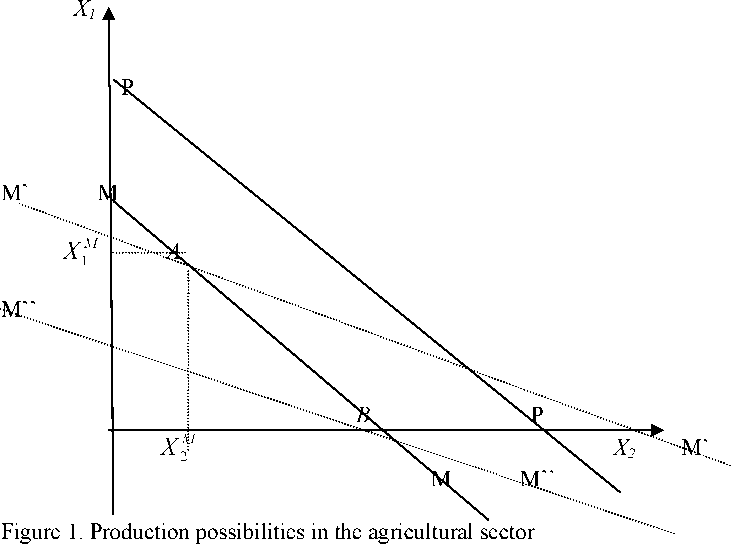In figure 1 we have drawn the production possibility frontier PP. The slope of PP equals -γ 2 ∕γ1 .
Suppose that the crisis menu is given by XM = (X1M , X2M ) marked as A in the figure. The
land requirement for producing X M is denoted LM , and the production possibility frontier given this
land requirement is the solid line MM.
Assume that we choose a level of land use that is not sufficient to guarantee complete food
security, thus we are only able to produce a share, λ, of the crisis menu. Define X=(X1,X2)= λXM . For
the moment we abstract from stockpiling and aid, and imports of the two commodities, μi, is treated as
uncertain. (1) can then be written as:
Pr(X+μ≥XM) ≥π; μ≥0,
where μ=(μ1, μ2). Pr(λXM+μ≥XM)< 1 for λ<1, and the probability is 1 when λ≥ 1.
The point of departure for Gulbrandsen and Lindbeck is an inefficient agricultural sector. This
means that the net cost per hectare land, NCHi, is positive:
(3)
NCHi
≡ Pl - Pw ɪ > 0
l xi
i γi
for both commodities. Without support nothing will be produced. Food security is an argument for
agricultural support, i.e. land must be available when a crisis arises.
Assume that it is more costly (per hectare) to produce X1 than X2, so NCH2<NCH1, and assume
that we require complete food security (λ=1).

More intriguing information
1. The name is absent2. The name is absent
3. Keystone sector methodology:network analysis comparative study
4. The name is absent
5. Testing Gribat´s Law Across Regions. Evidence from Spain.
6. The name is absent
7. PROFITABILITY OF ALFALFA HAY STORAGE USING PROBABILITIES: AN EXTENSION APPROACH
8. Reconsidering the value of pupil attitudes to studying post-16: a caution for Paul Croll
9. The Distribution of Income of Self-employed, Entrepreneurs and Professions as Revealed from Micro Income Tax Statistics in Germany
10. Intertemporal Risk Management Decisions of Farmers under Preference, Market, and Policy Dynamics